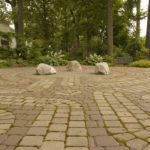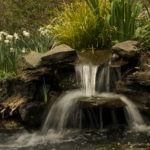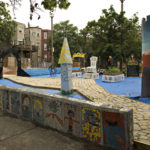Kids on the Hill Sculpture Garden
Creating community through creativity
When artist, activist and Firesoul Rebecca Yenawine moved to Reservoir Hill, she saw an opportunity to give neighborhood kids back their childhoods by sparking their creativity and creating a sculpture garden. Together with the help of Nature Sacred, they turned one abandoned lot into a safe space they could call their own and the whole community could enjoy—The Kids on the Hill Sculpture Garden.
Like so many inner city neighborhoods in America, the area surrounding Reservoir Hill in Baltimore City is deeply challenged with few essential resources. Despite many dedicated residents, there are abandoned lots and homes, an active drug trade, a struggling school, no supermarket and no economic infrastructure. And kids growing up in lower income neighborhoods like these face challenges many can never even imagine. The struggle to survive robs them of their childhoods.

Using art and imagination to unify
But when Firesouls like Rebecca see potential in at-risk kids like these children and cultivate that potential, it opens up worlds of possibilities. She viewed artists as truth-sayers and visionaries, influential forces who can imagine a better solution than war. She also believed art to be active and inclusive.
When she got to know the children in her new neighborhood, she found a way to put her ideologies to work. One day, she caught some teenaged girls spray painting. She took their spray paint and invited them into her house for an art lesson. They loved it and kept coming back. They got permission from the neighborhood association to paint over boarded windows and doors of three abandoned buildings.
That seeded the idea for an after-school program that became Kids on the Hill. Enter Nature Sacred, and the Kids on the Hill Sculpture Garden became their first summer camp project.

Building castles and self confidence
They began with castles as their theme. Every child knows that castles are where kings, queens, princes and princesses live, and they are powerful people. So Rebecca and the kids set out to create a castle in their kingdom where youth could be powerful. And she gave them a way to address issues of power and class.
To create each project, they’d first study, learning about castles and figuring out what imagery they liked. Then, they’d design the imagery and vote on which pictures they liked best. Then they brought those images to life, creating welded metal towers, a mosaic throne and table, benches for games and picnics and a wall of tile to serve as the surround (hyperlink).
She’d ask the children what they would change about their world to make it better if you were king or queen. “If I were king, I’d would make a type of skin lotion so everyone would have the same skin color and no one could be racist.” Their answers were then incorporated into pieces of sculpture they built, with the help of mosaic, casting and welding artists.
 Learning how to use power tools was a very empowering experience for the kids, especially the girls. They used circular saws, jigsaws, plasma cutters and welding electric grinders. Seeing one of the “girliest” girls wearing a welding hat and getting dirty was exciting for Rebecca. She observed the project building self confidence in every child who participated.
Learning how to use power tools was a very empowering experience for the kids, especially the girls. They used circular saws, jigsaws, plasma cutters and welding electric grinders. Seeing one of the “girliest” girls wearing a welding hat and getting dirty was exciting for Rebecca. She observed the project building self confidence in every child who participated.
Seeing is empowering
But the Kids on the Hill Sculpture Garden empowered them in another way, too. Their art is visible in their community. Therefore, they are visible. Every time they walk by the garden, they say, “I made that. That was my idea.” They see other people interact with their art, and that enhances their sense of self. The garden gives the kids a voice, a way to be seen and heard, a way to have ownership in the community.
Cleaning and kids? Yes.
Rebecca observed that ownership in action in the way they took care of the garden. When adults think of what kids can do for their community, it’s come out for a clean-up day. In her experience, that’s not what kids wanted to do. But she noticed that when they picked up trash in their sculpture garden, it was different. It doesn’t feel to them like they’re being used to pick up someone else’s junk. It feels more like they’re cleaning up their own rooms. And they get to enjoy their artwork.
Teaching teamwork
Another valuable lesson creating the sculpture garden taught the children was teamwork. It strengthened their connection to each other and, therefore, strengthened the community. Whether it was drawing designs, learning to use a tape measure, marking, cutting or welding, tasks were broken down, so each child knew what they were contributing to the group and how that was contributing to the final goal. Each project was a group effort from start to finish.

And there’s no end to the ideas community kids have come up with to add to The Kids on the Hill Sculpture Garden. Each year, a new project involves more children. For Rebecca, this is vital to creating an ongoing sense of ownership that will encourage younger children to be guardians of the art of those who came before them.
A safe and sacred space for all
The Kids on the Hill Sculpture Garden has grown from a vision for a block of concrete into a vibrant community gathering place. What was once an off-limits hangout for drug dealers is now a neighborhood hangout for everyone to enjoy.

The uses the community has found for the space are limitless. There are festivals year round. There are swimming parties in the fountain in the summer. There are movies shown on a big screen hung from the stage kids designed in one corner of the park. There are quiet moments on the signature Nature Sacred bench in another corner of the park. And we were honored to help transform this space into a viable and valuable part of this community.





